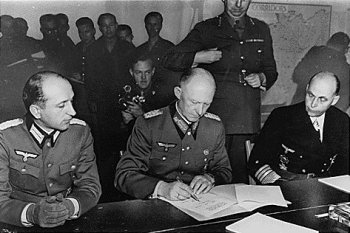
1945 (May 7) – In a small red brick schoolhouse in Reims, Germany, General Alfred Jodl signed the unconditional surrender of all German fighting forces thus ending World War II in Europe. Russian, American, British and French ranking officers observed the signing of the document which became effective at one minute past midnight on May 9th. Jodl was then ushered in to see Supreme Allied Commander, General Dwight D. Eisenhower, who curtly asked Jodl if he fully understood the document. Eisenhower then informed Jodl that he would be held personally responsible for any deviation from the terms of the surrender. Jodl was then ushered away.

1945 (May 8) – A second German surrender ceremony was held in Berlin. Soviet Russia’s leader Josef Stalin had refused to recognize the German surrender document signed a day earlier at Reims. This time, German Field Marshal Wilhelm Keitel signed the surrender document which declared, as did the first, that hostilities would end as of 12:01 a.m. on May 9th.

1943 (May 13) – During World War II in North Africa, over 250,000 Germans and Italians surrendered in the last few days of the Tunis campaign. British General Harold Alexander then telegraphed news of the victory to Winston Churchill, who was in Washington attending a war conference. The victory re-opened Allied shipping lanes in the Mediterranean.
1942 (May 14) – During World War II, an Act of Congress allowed women to enlist for noncombat duties in the Women’s Auxiliary Army Corps (WAAC), the Women Appointed for Voluntary Emergency Service (WAVES), Women’s Auxiliary Ferrying Squadron (WAFS), and Semper Paratus Always Ready Service (SPARS), the Women’s Reserve of the Marine Corp.



